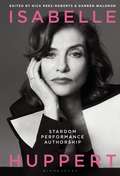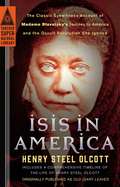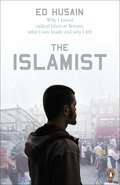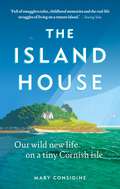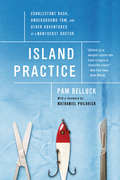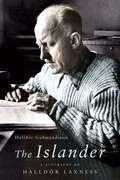- Table View
- List View
Isaac Newton: Remarkable Lives
by Robin Wilson Raymond FloodSir Isaac Newton (1642-1727), mathematician and physicist, is one of the foremost scientific intellects of all time. This fully illustrated, accessible guide to the life and work of Isaac Newton is the perfect introduction to his groundbreaking work on gravity, motion, optics, light, colour and calculus. It also considers his lesser known research into chemistry, theology and alchemy while assessing his continuing legacy. Organised chronologically, this book covers his childhood in rural Lincolnshire, school days in Grantham and undergraduate life at Trinity College, Cambridge. All of his major discoveries, breakthroughs and publications are lucidly described. Entries include: the story of the falling apple, Gravity and the Principia, Newton's laws of motion, Optics, Alchemy and Divinity, as well as his time as Warden of the Royal Mint in London. This is the essential guide to the life, work and legacy of one of the greatest geniuses of all time. Organised chronologically, this book covers his childhood in rural Lincolnshire, school days in Grantham and undergraduate life at Trinity College, Cambridge. All of his major discoveries, breakthroughs and publications are lucidly described. Entries include: the story of the falling apple, Gravity and the Principia, Newtons laws of motion, Optics, Alchemy and Divinity, as well as his time as Warden of the Royal Mint in London. This is the essential guide to the life, work and legacy of one of the greatest geniuses of all time.
Isaac Newton (Super Scientists)
by Sarah RidleySuper Scientists are first biographies introducing some of the world's great scientists, simply retelling their lives and explaining why their work was important. Illustrated with archive images and photographs, the chronology of each lifetime is emphasised by a timeline that runs through the book. Isaac Newton tells the story of this key scientific figure - covering his origins as the son of a farmer through his work in mechanics, optics and mathematics, his famous gravitational studies, and his enduring legacy today.
Isabella: She-Wolf of France, Queen of England
by Alison WeirDescribed by Christopher Marlowe as the 'She-Wolf of France', Isabella was one of the most notorious femme fatales in history. According to popular legend, her angry ghost can be glimpsed among church ruins, clutching the beating heart of her murdered husband. But how did Isabella aquire this reputation?Born in 1292 she married Edward II of England but was constantly humiliated by his relationships with male favourites and she lived adulterously with Roger Mortimer, 1st Earl of March. Had it not been for her unfaithfulness, history might have immortalised her as a liberator- the saviour who unshackled England from a weak and vicious monarch. Dramatic and startling this first full-length biography of Isabella will change the way we think of her and her world forever.
Isabella de'Medici: The Glorious Life and Tragic End of a Renaissance Princess
by Caroline P. MurphyIsabella de' Medici was the hostess of a glittering circle in Renaissance Florence. Beautiful and liberated, she not only matched the intellectual accomplishments of her male contemporaries, but sought sexual parity also, engaging in an adulterous affair with her husband's cousin. It was this affair - and her very success as First Lady of Florence - that led to her death at the hands of her husband at the age of just thirty-four. She left behind a remarkable story, and as her legacy a son who became the best of the Orsini Dukes, immortalised by Shakespeare as Duke Orsino in Twelfth Night. Caroline P. Murphy illuminates this often misunderstood figure, and in the process brings to life the home of creativity, the city of Florence itself.
Isabella Stewart Gardner: A Life
by Nathaniel Silver Diana Seave GreenwaldA major new biography of legendary art collector and philanthropist Isabella Stewart GardnerIsabella Stewart Gardner (1840–1924) assembled an extraordinary collection of art from diverse cultures and eras—and built a Venetian-style palazzo in Boston to share these exquisite treasures with the world. But her life and work remains shrouded in myth. Separating fiction and fact, this book paints an unforgettable portrait of Gardner, drawing on her substantial personal archive and including previously unpublished findings to offer new perspectives on her life and her construction of identity.Nathaniel Silver and Diana Seave Greenwald shed new light on Gardner's connections to minority communities in Boston, her views on suffrage and other issues of the day, the sources of her and her husband’s wealth, and her ties to politicians, writers, and artists. What emerges is a multifaceted portrait of a trailblazing collector and patron of the arts—from Italian Renaissance paintings to Chinese antiquities—who built a museum unprecedented in its curatorial vision.Beautifully illustrated, this book challenges any portrayal of Gardner as a straightforward feminist hero, revealing instead an exceptional, complex woman who created a legendary museum and played a vibrant and influential role in the art world.Distributed for the Isabella Stewart Gardner Museum
Isabella Stewart Gardner: A Life
by Nathaniel Silver Diana Seave GreenwaldA major new biography of legendary art collector and philanthropist Isabella Stewart GardnerIsabella Stewart Gardner (1840–1924) assembled an extraordinary collection of art from diverse cultures and eras—and built a Venetian-style palazzo in Boston to share these exquisite treasures with the world. But her life and work remains shrouded in myth. Separating fiction and fact, this book paints an unforgettable portrait of Gardner, drawing on her substantial personal archive and including previously unpublished findings to offer new perspectives on her life and her construction of identity.Nathaniel Silver and Diana Seave Greenwald shed new light on Gardner's connections to minority communities in Boston, her views on suffrage and other issues of the day, the sources of her and her husband’s wealth, and her ties to politicians, writers, and artists. What emerges is a multifaceted portrait of a trailblazing collector and patron of the arts—from Italian Renaissance paintings to Chinese antiquities—who built a museum unprecedented in its curatorial vision.Beautifully illustrated, this book challenges any portrayal of Gardner as a straightforward feminist hero, revealing instead an exceptional, complex woman who created a legendary museum and played a vibrant and influential role in the art world.Distributed for the Isabella Stewart Gardner Museum
Isabelle Huppert: Stardom, Performance, Authorship
by Nick Rees-Roberts and Darren WaldronFeaturing a lineup of distinguished academics, this collection remedies the absence of scholarly attention on French cinematic legend Isabelle Huppert. This volume deconstructs Huppert's star persona and public profile through critical and theoretical analysis of her various screen roles-from her very early appearances alongside Romy Schneider in César et Rosalie (Sautet, 1972) and Gérard Depardieu in Les Valseuses (1974) to a number of celebrated collaborations with high-profile European auteurs such as Catherine Breillat, Claire Denis, Jean-Luc Godard, Michael Haneke and Joseph Losey, and with more popular auteurs such as Claude Chabrol and François Ozon. Known for a cerebral internalization of characterization, a technical mastery of extreme emotions, and a singular brand of icy intellectualism, Huppert's performances continue to impress, stun and surprise audiences. By focusing on several theoretical questions that relate to image, identity, sexuality and place, this volume situates Huppert's star persona in the more practical creative contexts of performance, authorship, genre and collaboration. This volume contrasts complementary critical accounts of her stardom by working across the different periods and territories of her career.
Isabelle Huppert: Stardom, Performance, Authorship
Featuring a lineup of distinguished academics, this collection remedies the absence of scholarly attention on French cinematic legend Isabelle Huppert. This volume deconstructs Huppert's star persona and public profile through critical and theoretical analysis of her various screen roles-from her very early appearances alongside Romy Schneider in César et Rosalie (Sautet, 1972) and Gérard Depardieu in Les Valseuses (1974) to a number of celebrated collaborations with high-profile European auteurs such as Catherine Breillat, Claire Denis, Jean-Luc Godard, Michael Haneke and Joseph Losey, and with more popular auteurs such as Claude Chabrol and François Ozon. Known for a cerebral internalization of characterization, a technical mastery of extreme emotions, and a singular brand of icy intellectualism, Huppert's performances continue to impress, stun and surprise audiences. By focusing on several theoretical questions that relate to image, identity, sexuality and place, this volume situates Huppert's star persona in the more practical creative contexts of performance, authorship, genre and collaboration. This volume contrasts complementary critical accounts of her stardom by working across the different periods and territories of her career.
Isaiah Berlin: An Interpretation of His Thought
by John GrayIsaiah Berlin (1909-1997) was the greatest intellectual historian of the twentieth century. But his work also made an original and important contribution to moral and political philosophy and to liberal theory. In 1921, at the age of eleven, Isaiah Berlin arrived in England from Riga, Latvia. By the time he was thirty he was at the heart of British intellectual life. He has remained its commanding presence ever since, and few would dispute that he was one of Britain's greatest thinkers. His reputation extends worldwide--as a great conversationalist, intellectual historian, and man of letters. He has been called the century's most inspired reader. Yet Berlin's contributions to thought--in particular to moral and political philosophy, and to liberal theory--are little understood, and surprisingly neglected by the academic world. In this book, they are shown to be animated by a single, powerful, subversive idea: value-pluralism which affirms the reality of a deep conflict between ultimate human values that reason cannot resolve. Though bracingly clear-headed, humane and realist, Berlin's value-pluralism runs against the dominant Western traditions, secular and religious, which avow an ultimate harmony of values. It supports a highly distinctive restatement of liberalism in Berlin's work--an agnostic liberalism, which is founded not on rational choice but on the radical choices we make when faced with intractable dilemmas. It is this new statement of liberalism, the central subject of John Gray's lively and lucid book, which gives the liberal intellectual tradition a new lease on life, a new source of life, and which comprises Berlin's central and enduring legacy. In a new introduction, Gray argues that, in a world in which human freedom has spread more slowly than democracy, Berlin's account of liberty and basic decency is more instructive and useful than ever.
Isaiah Berlin: An Interpretation of His Thought
by John GrayIsaiah Berlin (1909-1997) was the greatest intellectual historian of the twentieth century. But his work also made an original and important contribution to moral and political philosophy and to liberal theory. In 1921, at the age of eleven, Isaiah Berlin arrived in England from Riga, Latvia. By the time he was thirty he was at the heart of British intellectual life. He has remained its commanding presence ever since, and few would dispute that he was one of Britain's greatest thinkers. His reputation extends worldwide--as a great conversationalist, intellectual historian, and man of letters. He has been called the century's most inspired reader. Yet Berlin's contributions to thought--in particular to moral and political philosophy, and to liberal theory--are little understood, and surprisingly neglected by the academic world. In this book, they are shown to be animated by a single, powerful, subversive idea: value-pluralism which affirms the reality of a deep conflict between ultimate human values that reason cannot resolve. Though bracingly clear-headed, humane and realist, Berlin's value-pluralism runs against the dominant Western traditions, secular and religious, which avow an ultimate harmony of values. It supports a highly distinctive restatement of liberalism in Berlin's work--an agnostic liberalism, which is founded not on rational choice but on the radical choices we make when faced with intractable dilemmas. It is this new statement of liberalism, the central subject of John Gray's lively and lucid book, which gives the liberal intellectual tradition a new lease on life, a new source of life, and which comprises Berlin's central and enduring legacy. In a new introduction, Gray argues that, in a world in which human freedom has spread more slowly than democracy, Berlin's account of liberty and basic decency is more instructive and useful than ever.
Isaiah Berlin: A Life
by Michael IgnatieffIsaiah Berlin refused to write an autobiography, but he agreed to talk about himself - and so for ten years, he allowed Michael Ignatieff to interview him. Isaiah Berlin (1909-97) was one of the greatest and most humane of modern philosophers; historian of the Russian intellgentisia biographer of Marx, pioneering scholar of the Romantic movement and defender of the liberal idea of freedom. His own life was caught up in the most powerful currents of the century. The son of a Riga timber merchant, he witnessed the Russian Revolution, was plunged into suburban school life and the ferment of 1930s Oxford; he became part of the British intellectual establishment During the war, he as at the heart of Anglo-American diplomacy in Washington; afterwards in Moscow he saw the grim despair of Stalinism. The book is full of memorable meetings - with Virginia Woolf and Sigmund Freud, with Churchill, with Boris Pasternak and Anna Akhmatova. Yet Ignatieff is not afraid to delve into Berlin's conflicts: his jewish idealism, his deep aspirations. This is a work of great subtelty and penetration, exhilarating and intimate, powerful and profound.
Ishiro Honda: A Life in Film, from Godzilla to Kurosawa
by Steve Ryfle Ed GodziszewskiIshiro Honda was arguably the most internationally successful Japanese director of his generation, with an unmatched succession of science fiction films that were commercial hits worldwide. From the atomic allegory of Godzilla and the beguiling charms of Mothra to the tragic mystery of Matango and the disaster and spectacle of Rodan, The Mysterians, King Kong vs. Godzilla, and many others, Honda's films reflected postwar Japan's real-life anxieties and incorporated fantastical special effects, a formula that appealed to audiences around the globe and created a popular culture phenomenon that spans generations. Now, in the first full account of this long overlooked director's life and career, authors Steve Ryfle and Ed Godziszewski shed new light on Honda's work and the experiences that shaped it—including his days as a reluctant Japanese soldier, witnessing the aftermath of Hiroshima, and his lifelong friendship with Akira Kurosawa. Ishiro Honda: A Life in Film, from Godzilla to Kurosawa features close analysis of Honda's films (including, for the first time, his rarely seen dramas, comedies, and war films) and draws on previously untapped documents and interviews to explore how creative, economic, and industrial factors impacted his career. Fans of Honda, Godzilla, and tokusatsu (special effects) film, and of Japanese film in general, will welcome this in-depth study of a highly influential director who occupies a uniquely important position in science fiction and fantasy cinema, as well as in world cinema. Together, the authors have provided audio commentary tracks and produced supplemental material for numerous home video releases, including Ishiro Honda's Godzilla for the British Film Institute. They co-produced the documentary feature Bringing Godzilla Down to Size (2008).
The ISIS Hostage: One Man's True Story of 13 Months in Captivity
by Puk DamsgårdThe Number One International BestsellerThe dramatic story of freelance photographer Daniel Rye, who was held hostage for 13 months by ISIS, as told by an award-winning writer.In May 2013, freelance photographer Daniel Rye was captured in Syria and held prisoner by Islamic State for thirteen months, along with eighteen other hostages. The ISIS Hostage tells the dramatic and heart-breaking story of Daniel's ordeal and details the misery inflicted upon him by the British guards, which included Jihadi John.This tense and riveting account also follows Daniel's family and the nerve-wracking negotiations with his kidnappers. It traces their horrifying journey through impossible dilemmas and offers a rare glimpse into the secret world of the investigation launched to locate and free not only Daniel, but also the American journalist and fellow hostage James Foley.Written with Daniel's full cooperation and based on interviews with former fellow prisoners, jihadists and key figures who worked behind the scenes to secure his release, The ISIS Hostage reveals for the first time the torment suffered by the captives and tells a moving and terrifying story of friendship, torture and survival.
Isis in America: The Classic Eyewitness Account of Madame Blavatsky's Journey to America and the Occult Revolution She Ignited (Tarcher Supernatural Library)
by Henry OlcottTheosophical Society cofounder Colonel Henry Steel Olcott's memoirs cover his years with Madame Helena Petrovna Blavatsky and the birth of the American occult--part of the new Tarcher Supernatural Library. <P><P> There are few more intriguing, or polarizing, figures in modern American spiritual history than Madame Helena Petrovna Blavatsky. The cofounder of the Theosophical Society, Blavatsky remains a figure of fascination more than a century after her death. In Isis in America--one of the most unique documents of recent American spiritual history--we get a closer look at Blavatsky, through the eyes of Theosophical Society cofounder, writer, lawyer, investigator, and Blavatsky confidant Henry Steel Olcott. Olcott spent years by Blavatsky's side, witnessing acts of aura projection and spontaneously produced objects--and undergoing his own spiritual awakening--as they laid the foundations for a new era in esoteric spirituality. This special edition features a comprehensive timeline of the life of Henry Steel Olcott by Mitch Horowitz. <P><P> The first three titles released in Tarcher's Supernatural Library are Ghost Hunter (by Hans Holzer), Romance of Sorcery (by Sax Rohmer) and Isis in America (by Henry Steel Olcott).
The Islamist: Why I Joined Radical Islam In Britain, What I Saw Inside And Why I Left
by Ed HusainWhen I was sixteen I became an Islamic fundamentalist. Five years later, after much emotional turmoil, I rejected fundamentalist teachings and returned to normal life and my family. I tried to put my experiences behind me, but as the events of 7/7 unfolded it became clear to me that Islamist groups pose a threat to this country that we - Muslims and non-Muslims alike - do not yet understand. Why are young British Muslims becoming extremists? What are the risks of another home-grown terrorist attack on British soil? By describing my experiences inside these groups, the reasons I joined them and how, after leaving I recovered my faith and mind, I hope to explain the appeal of extremist thought, how fanatics penetrate Muslim communities and the truth behind their agenda of subverting the West and moderate Islam. Writing candidly about life after extremism, I illustrate the depth of the problem that now grips Muslim hearts and minds. I will lay bare what politicians and Muslim 'community leaders' do not want you to know. This is the first time an ex-member openly discusses life within radical Islamic organisations. This is my story.
The Island: War and Belonging in Auden’s England
by Nicholas JenkinsA groundbreaking reassessment of W. H. Auden’s early life and poetry, shedding new light on his artistic development as well as on his shifting beliefs about political belonging in interwar England.From his first poems in 1922 to the publication of his landmark collection On This Island in the mid-1930s, W. H. Auden wrestled with the meaning of Englishness. His early works are prized for their psychological depth, yet Nicholas Jenkins argues that they are political poems as well, illuminating Auden’s intuitions about a key aspect of modern experience: national identity. Two historical forces, in particular, haunted the poet: the catastrophe of World War I and the subsequent “rediscovery” of England’s rural landscapes by artists and intellectuals.The Island presents a new picture of Auden, the poet and the man, as he explored a genteel, lyrical form of nationalism during these years. His poems reflect on a world in ruins, while cultivating visions of England as a beautiful—if morally compromised—haven. They also reflect aspects of Auden’s personal search for belonging—from his complex relationship with his father, to his quest for literary mentors, to his negotiation of the codes that structured gay life. Yet as Europe veered toward a second immolation, Auden began to realize that poetic myths centered on English identity held little potential. He left the country in 1936 for what became an almost lifelong expatriation, convinced that his role as the voice of Englishness had become an empty one.Reexamining one of the twentieth century’s most moving and controversial poets, The Island is a fresh account of his early works and a striking parable about the politics of modernism. Auden’s preoccupations with the vicissitudes of war, the trials of love, and the problems of identity are of their time. Yet they still resonate profoundly today.
Island Boy: Valentia, Skellig and my life at the ocean’s edge
by Des Lavelle‘There were twenty-five hours in my day then ... any job or challenge that the ocean or the harbour might offer was an option. I undertook them all.’ Des Lavelle was born on Valentia Island in County Kerry in 1934, surrounded by the wild Atlantic waters. Known to the world for his passion for the nearby Skellig Islands, Des has led a fascinating and varied life, but his heart forever draws him back to Valentia. His wide-ranging memoir takes us on an extraordinary journey from an idyllic childhood on Valentia, through a short-lived ‘permanent, pensionable job’ with the Western Union Telegraph Company to a rich and fascinating life where the sea always offered opportunities. When the movie Ryan’s Daughter needed marine advice in 1968, they came to Des. In 1974 a North Sea oil rig sought him out to help with a giant safety net, and a few years later his special skills came to the fore once more as Telecom Éireann laid their cables under the waves. From sea-faring on his beloved 32ft Béal Bocht to pioneering deep-sea diving, running a ferry, campaigning for his beloved island outpost, crewing with the Valentia lifeboat and travelling to far-flung places, Des Lavelle shares his ups and downs on his road to becoming a renowned author and expert on the historical and wildlife riches of Kerry’s intriguing Skellig Islands. Island Boy is the compelling story of a man born and raised in Valentia and of a unique life that he continues to live to the full.
Island Dreams: Mapping an Obsession (Canons)
by Gavin FrancisSHORTLISTED FOR WATERSTONES BOOK OF THE YEARIn Island Dreams, Gavin Francis combines stories of his own travels with psychology, philosophy and myth, shedding new light on the importance of islands and isolation in our collective consciousness.Francis draws on thirty years of island adventures from the Faroe Islands to the Aegean, from the Galapagos to the Andaman Islands. He contrasts these quests for freedom with the demands for commitment required as a doctor, community member and parent. Island Dreams riffs on the twin poles of rest and motion, independence and attachment, never more relevant than in today’s ever-connected world.
Island Home: A landscape memoir
by Tim Winton'I grew up on the world's largest island.'From his childhood, Tim Winton's relationship with the landscape around him - Australia's swamps and bush, rockpools, seacaves and scrub - has been as vital as any other connection. Whether camping in hidden inlets, walking in the high rocky desert fringe, or diving at Ningaloo Reef, Winton has felt the place seep into him - its rhythms, its dangers, its strange sustenance.Island Home is the story of how that relationship with the landscape came to be. Charged with love for the huge, besieging force of Australia's wild spaces, this book is a passionate call for their conservation, a memoir that urges us all to feel the ground beneath our feet. Tim Winton's Land's Edge: A Coastal Memoir, is also available from Picador.
The Island House: Our Wild New Life on a Tiny Cornish Isle
by Mary Considine'In the January dark, a young man walks slowly into the sea. He can't see where he is going, but he knows the island is calling...'Mary and Patrick's dream was to live in London, have 2.4 children, the nice house, the successful jobs. But life had other plans, and in one traumatic year that all came crashing down.Bruised and battered, Mary finds herself pulled towards Cornwall and dreams of St George's Island, where she spent halcyon childhood summers. So, when an opportunity arises to become tenants if they renovate the old Island House, they grab it with both hands.Life on the island is hard, especially in winter, the sea and weather, unforgiving. But the rugged natural beauty, the friendly ghosts of previous inhabitants, and the beautiful isolation of island life bring hope and purpose, as they discover a resilience they never knew they had.
Island on the Edge: an extraordinary journey from city life to rural idyll
by Anne CholawoAnne Cholawo was a typical 80s career girl working in a busy London advertising agency, when in 1989, holidaying in Skye, she noticed an advert for a property on the Isle of Soay – 'Access by courtesy of fishing boat'. She had never heard of Soay before, let alone visited it, but something inexplicable drew her there. Within ten minutes of stepping off the said fishing boat, she had fallen under the spell of the island, and after a few months she moved there to live. She is still there. When she arrived on the remote west coast island there were only 17 inhabitants, among them the legendary Hebridean sharker Tex Geddes and his family. Today, including Anne and her husband Robert, there are only three. This book describes her extraordinary transition from a hectic urban lifestyle to one of rural isolation and self-sufficiency, without mains electricity, medical services, shops or any of the other modern amenities we take for granted. Anne describes the history of Soay and its unique wildlife, and as well as telling her own personal story introduces along the way some of the off-beat and colourful characters associated with the island, notably Tex's one-time associate, the celebrated writer and naturalist, Gavin Maxwell.
Island Practice: Cobblestone Rash, Underground Tom, and Other Adventures of a Nantucket Doctor
by Pam BelluckWith a Foreword by Nathaniel Philbrick, author of the bestseller In the Heart of the SeaIf you need an appendectomy, he can do it with a stone scalpel he carved himself. If you have a condition nobody can diagnose—“creeping eruption” perhaps—he can identify what it is, and treat it. A baby with toe-tourniquet syndrome, a human leg that’s washed ashore, a horse with Lyme disease, a narcoleptic falling face-first in the street, a hermit living underground—hardly anything is off-limits for Dr. Timothy J. Lepore.This is the spirited, true story of a colorful, contrarian doctor on the world-famous island of Nantucket. Thirty miles out to sea, in a strikingly offbeat place known for wealthy summer people but also home to independent-minded, idiosyncratic year-rounders, Lepore holds the life of the island, often quite literally, in his hands. He’s surgeon, medical examiner, football team doctor, tick expert, unofficial psychologist, accidental homicide detective, occasional veterinarian. When crisis strikes, he’s deeply involved.He’s treated Jimmy Buffett, Chris Matthews, and various Kennedy relatives, but he makes house calls for anyone and lets people pay him nothing—or anything: oatmeal raisin cookies, a weather-beaten .44 Magnum, a picture of a Nepalese shaman.Lepore can be controversial and contradictory, espousing conservative views while performing abortions and giving patients marijuana cookies. He has unusual hobbies: he’s a gun fanatic, roadkill collector, and concocter of pastimes like knitting dog-hair sweaters.Ultimately, Island Practice is about a doctor utterly essential to a community at a time when medicine is increasingly money-driven and impersonal. Can he remain a maverick even as a healthcare chain subsumes his hospital? Every community has—or, some would say, needs—a Doctor Lepore, and his island’s drive to retain individuality in a cookie-cutter world is echoed across the country.
Island Summers: Memories of a Norwegian Childhood
by Tilly Culme-Seymour'My grandmother bought the island. The year was 1947 and she was thirty-three, a couple of years older than I am now. She was the visionary sort of person who can make something magical out of very little.'From the moment that Tilly's grandmother, Mor-mor, set eyes on the rocky outline of Småhølmene, it captured her imagination. Legend has it that she bought the island in exchange for a mink coat.Every summer from then on, she and her young family would escape from their life in the English countryside to its rugged outcrops and sparkling waters. Mor-mor loved Småhølmene fiercely. Lean and chic, she smoked voraciously and would scandalise the local islanders by roaming around naked, flanked by her standard black poodle, Cheri. Her children spent their days running wild, thieving for gull eggs, rowing on the lagoon, and foraging for island raspberries, which Mor-mor would sandwich together with whipped cream to make into a sukkerkake.Thirty-five years later, Tilly spent her first summer on Småhølmene. Her Mamma kept up the rituals that she herself had learnt from Mor-mor, and Tilly discovered in the island a living link between her family's past and its present. Glittering and bittersweet, this is the captivating story of the women who made Småhølmene their own: a land of childhood adventures, of magical summers, and of Tilly's first romance.
Island Wife: living on the edge of the wild
by Judy FairbairnsDream of living on a remote Scottish island? ISLAND WIFE tells one woman's true life story from 19-year-old bride to mother of five, running a family hotel a recording studio and a whale watching business. By turns unflinching, moving and very funny, this is a memoir of a 40 year marriage and a woman's extraordinary life.'A hugely entertaining story of family travails and triumphs' KIRSTY WARK'A sensitive, brave and honest look at a life lived in the wake of others' needs' DAILY MAILJudy, at 19, met her future husband, who whisked her off into an adventure, a marriage of over forty years, and a life on a remote Hebridean island. Along the way she bears five children, learns how to run a rocky hill farm, a hotel, a recording studio and the first whale watching business in the UK - all the while inventively making fraying ends meet. When her children start to leave home, things fall apart and there is sadness and joy in how she puts things back together. Funny and tender, this is a book of endless horizons and a breath of fresh air. It is also the story of a creative woman coming out from under and finding her true self.
The Islander: A Biography of Halldor Laxness
by Halldor Gudmundsson"An enthralling, heartening study of a man of unflagging interest in life" Independent"A thoroughly researched biography" New York Review of Books"Provides readers of English with a perfect introduction to the life and works of an outstanding writer, one whom everyone should read" Irish Times"I am thoroughly convinced by Gudmundsson's portrayal of Laxness" J. M COETZEEA strong and memorable portrayal of a man who fought heroically to write for the world, but in one of its rarest languages. Halldór Laxness won the Nobel Prize for literature in 1955. During his life, which spanned nearly the entire century, he not only wrote sixty books, but also became an active participant in Europe's idealistic debates and struggles.In the 1930s, Laxness became attracted to Soviet communism. He travelled widely in the Soviet Bloc and, despite witnessing some atrocities, remained a defender of communism until the 1960s. But his political leanings never dominated his work. Laxness continually sought to divulge the world of beauty that lurks beneath the everyday, ensuring his artistry remained a sanctuary of humanism and reflection.In this biography, Guðmundsson has been granted access to unique material by Laxness' family. As a result, the interrelationships between Laxness' personal life, his politics and his career are meticulously examined. What emerges is a grand description of a fascinating personality in which the manifold conflicts of the 20th century are mirrored."Laxness is a writer of the first degree, a writer I dreamed of coming close to" BORIS PASTERNAK, 1960"When in a bad mood I have picked one of your books. And there the pure and deep sound has welcomed me, strong and charming from the first page" KAREN BLIXEN in an open letter to Laxness in 1952Translated from Icelandic by Philip Roughton






